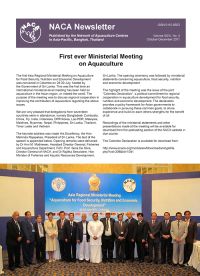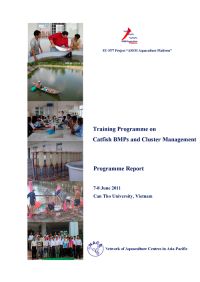In this issue:
First ever Ministerial Meeting on aquaculture. Keynote address delivered by His Excellency, Mahinda Rajapaksa, President of Sri Lanka. Farewell Sena and welcome Eknath! 2nd Regional Training Course on Application of Business Management Principles in Small Scale Aquaculture. Consultation on Lake and Reservoir Fisheries and Aquaculture Development in Asia. Asia Regional Seminar on Certification for Small Scale Aquaculture in Thailand. Special issue of the AFS Journal: Integrated technologies for advanced shrimp production. Farmers as Stakeholders in Commercial Aquaculture: Free download. Marker for banned antibiotic naturally occurs in freshwater prawns and other crustaceans.
This is the report of a training programme on better management practices (BMPs) for catfish aquaculture and cluster-based management, which was held at the Faculty of Fisheries and Aquaculture, Can Tho University, Vietnam, 7-8 June 2011. The purpose of the training programme was to build capacity and awareness of selected cluster leaders, lead farmers and provincial extension officers on catfish BMPs, implementation of BMPs, group formation and operation.
Opening ceremony of the National Workshop on Scaling up of Shrimp Better Management Practices at the National Level, held in India, July 2011.
Sena De Silva presents on better management practices and cooperatives as a means for small-scale farmers to ramain competitive and sustainable.


